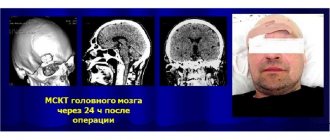Causes of brain germinoma
There is no clear opinion about the cause of the formation of brain germinoma. Scientists and oncologists are more inclined to the version of the disorder in the process of embryogenesis. There is a so-called dysontogenetic theory of the occurrence of this type of tumor. According to this theory, brain germinoma occurs as a result of disorders of tissue differentiation and tissue migration at the very first stages of embryogenesis in the first trimester of pregnancy. The basis of this hypothesis is largely based on the fact that neoplasms are more often detected in people at a young age.
Germinoma is usually classified as a type of embryonic tumor, and these neoplasms arise and develop even before the full formation of the fetus from the rudiments of embryonic tissues. The reason is a violation of embryogenesis, which occurs as a result of changes in the structure of chromosomes and mutation of genes that control the normal development of embryogenesis.
Factors that induce changes and disturbances in embryogenesis may have an indirect or direct effect on the body of the expectant mother. Such provocateurs include contact with toxic substances during pregnancy, the influence of radioactive substances, various types of infections (measles, herpes, severe stages of influenza). The risk factor will also be the influence of carcinogens.
Causes
Medical research and observations of the general picture of the development of the disease indicate that the main cause of germinoma is disturbances during embryonic development.
Active formation of the embryo's brain occurs already at 4-5 weeks of pregnancy. Adverse effects on the fetus during this period can have a particularly detrimental effect on these processes and lead to serious violations. First of all, this concerns the effects of medications, chemicals, intoxications (alcohol, smoking, drugs), hypoxia, and severe infectious diseases of the mother.
Symptoms of brain germinoma
The clinical picture of brain germinoma largely depends on its location. Localization of brain germinoma - deep structures of the brain - area of the pineal gland, third ventricle.
One of the first signs of this neoplasm will be impaired blood flow and hydrocephalus as a consequence. Patients often complain of a bursting headache that is not relieved by analgesics or other painkillers. There is also a feeling of pressure in the eyes, constant nausea, independent of meals, and at times even vomiting. Visual impairment is often observed. This is explained by the fact that germinoma is localized near the chiasm of the optic nerves and, growing, infringes on them. Patients focus on double vision, visual field defects, farsightedness or myopia.
The clinical picture of brain germinoma is also characterized by deterioration or partial loss of memory, mental disorders, and emotional instability. In some cases, various kinds of neuroendocrine syndromes such as diabetes insipidus, as well as menstrual irregularities, anovulation, amenorrhea in women and disorders in the hypothalamic-pituitary system may be observed. Developmental disorders of puberty are also diagnosed. All these symptoms are explained by the location of the tumor near the hypothalamus.
Diagnosis of brain germinoma
The first diagnostic conclusions are made during the first examination by a neurologist. A neurological examination and questioning of the patient, his complaints and accents in the characteristics of general well-being makes it possible to establish or suspect the presence of hydrocephalus.
Methods for diagnosing brain germinoma:
- Echo-encephalogram. Firstly, it allows you to diagnose intracranial pressure, and secondly, in the case of a large tumor, this diagnostic method can reveal displacement of the deep structures of the brain.
- Tomographic methods - CT and MRI of the brain. They make it possible to identify the nature of the tumor, location and size. Almost half of patients diagnosed with brain germinoma have a clinical picture of tumor infiltration of the visual tuberosities and petrification in the middle (the so-called butterfly symptom). This diagnosis can be confirmed by the presence of tumor bodies in the lateral ventricles and metastases in the infundibular region of the third ventricle.
- Biochemical blood test - establishing markers of hCG, ACE, PAL.
- Steretactic brain biopsy. This method will be the most accurate in making a diagnosis, since a laboratory examination of the tumor body is performed. In some cases, such a study may not give accurate results if the tumor is heterogeneous.
- Morphological examination of tumor areas after its removal. The difficulty of this method is in localizing the tumor in the deep structures of the brain, so doctors often prefer stereotactic biopsy.
Brain germinoma has a similar clinical picture to a number of neoplasms in the central nervous system, and therefore requires careful diagnosis and differentiation from diseases with similar symptoms. Among these diseases:
- astrocytoma;
- glioma;
- ganglioneuroma;
- hematoblastoma;
- medulloblastoma;
- brain abscess;
- intracerebral hematoma;
- cystosis in the third ventricle.
Diagnostic criteria
Brain germinoma is a very terrible and difficult to treat pathology, so it is necessary to apply special timely diagnostic measures and prescribe emergency therapy.
The most difficult thing is to diagnose this tumor in time, since its location is in the deep parts of the brain. Therefore, this complicates diagnosis as well as treatment.
In the first stages of life, it is very difficult to examine and identify this pathology, because the neoplasm is initially hidden.
Diagnosis can only be made once the patient reaches 10 years of age. The main primary factor indicating the presence of germinoma is increased intracranial pressure, so the formation can be detected at this stage using electroencephalography.
The next stage of the examination is a computer tomography and MRI (magnetic resonance imaging) of the brain. At this stage, the size, location and nature of the neoplasm are established.
The patient then takes a blood test. Laboratory testing should detect the contents of tumor markers (hCG, AFP, PAL) in the blood.
The most effective and accurate way to determine a tumor is a biopsy. Although for this pathology this method is not always justified. Since due to the fact that the structure of the tumor is uneven, it is impossible to accurately diagnose, and due to the deep location of the tumor, this procedure becomes more complicated. Therefore, doctors in many cases exclude this diagnostic method.
It also requires differentiation from other brain tumors, as well as from the accumulation of pus and blood in the brain and colloid cyst of the 3rd ventricle.
Treatment of brain germinoma
The most common treatment strategy for brain germinoma is radiation therapy. If the patient’s age is too young, their general condition does not allow radiation therapy, or there are contraindications, then polychemotherapy is prescribed. Sometimes surgery will be a mandatory and forced method of treatment and may be accompanied by radiation or chemotherapy. But such a complex method of treating this disease is extremely undesirable for young or child patients, as it entails severe intoxication of the entire body.
Treatment methods
When germinoma is diagnosed, treatment is carried out only through surgery. Today, several techniques are used, each of which has its own characteristics, indications and contraindications.
Self-medication is dangerous with complications!
Attention
Despite the fact that our articles are based on trusted sources and have been tested by practicing doctors, the same symptoms can be signs of different diseases, and the disease may not proceed according to the textbook.
Pros of seeing a doctor:
- Only a specialist will prescribe suitable medications.
- Recovery will be easier and faster.
- The doctor will monitor the course of the disease and help avoid complications.
find a doctor
Do not try to treat yourself - consult a specialist.
Radiation therapy
Germinoma is characterized by increased sensitivity to both radioactive and chemical radiation. That is why the main method is radiation therapy.
But it is not always possible to use it. This is due to the early age of the patients, since the tumor is detected when the child reaches 10 years of age or earlier.
Radiation therapy is contraindicated in children due to the negative effects of rays on an unformed organism. Treatment with radiation therapy is prescribed to patients over the age of 18 years.
Polychemotherapy
When treating neoplasms in children, specialists more often use polychemotherapy.
ATRO brain tumor
The brain controls the execution of all processes in the human body.
The technique involves influencing the tumor with the help of drugs. In this case, the doctor prescribes not one drug, as with chemotherapy, but a complex. When taken together, they can reduce the prevalence of formation or slow down its development.
Polychemotherapy is not able to completely cure the disease, but it allows you to gain time until chemotherapy is contraindicated.
Surgical removal
Surgical removal of a tumor formed in the brain is the most difficult task in neurosurgery. This is due to difficult access to areas of the cerebral cortex where the tumor is most often located.
But despite all the difficulties, the operation can be carried out. Surgical removal of germinoma is prescribed only when other methods do not bring results or there are contraindications for their implementation.
When prescribing surgical removal, the choice of access to the tumor is determined by the doctor after carefully studying the research results, the size and location of the tumor.
Often the procedure is performed using bypass surgery. Contraindications for surgical removal include unclear and rapid growth of the tumor and its location in an area where access is impossible.
A complex approach
In certain cases, the specialist prescribes complex treatment, which uses polychemotherapy and radiation therapy as an addition to surgery.
But an integrated approach to treating patients under the age of 18 is used in rare cases. This is due to severe intoxication of the body. But if each method separately is ineffective, complex therapy is prescribed.
The choice of treatment method for brain germinoma is made by the attending physician after studying the diagnostic results, its location and size.
Particular attention is paid when treating young children, since their bodies are still weak and may respond differently to chemotherapy.
Surgery
Surgical treatment of brain germinoma can be carried out in various ways and is performed when an accurate diagnosis is made and the location, nature and size of the tumor is established. Often, surgical treatment is the only possible method, since other methods will be ineffective. In some cases, surgical intervention requires additional procedures - ventriculocisternostomy or ventriculoperitoneostomy.
Contraindications for surgical treatment of brain germinoma may include inoperable location of the tumor or disseminated tumor growth, as well as multiple foci. If the size of the tumor is small, then it is advisable to use radiosurgery methods. The essence is a single exposure to the location of the tumor with a high dose of radiation.
Treatment of the disease is within the competence of specialized departments of neurosurgery, which are equipped with equipment and a computer imaging neuronavigation system.
Treatment
Two methods are successfully used in the treatment of germinoma: chemotherapy and radiotherapy. They are most effective in the earliest stages; in advanced stages, additional methods are used in addition to them. Due to the negative impact on developing brain tissue, the use of radioactive radiation is contraindicated in early childhood. Therefore, in children, due to the impossibility of full-fledged radiation therapy, combined administration of cytostatic drugs is often used. Chemotherapy and radiotherapy can be used after excision of a malignant tumor, as the “final” stage of treatment.
Today, in the practice of a neurologist and neurosurgeon, the most difficult thing is the removal of tumors located in the deep structures of the brain. It is not always possible to find access to the tumor without damaging healthy tissue.
The development of new surgical instruments and devices for performing operations, access techniques and research methods have made it possible to carry out interventions with a high percentage of success. If previously such tumors were considered inoperable, now a different point of view has arisen on this. In addition, the surgical treatment method is always the most preferable, since it often completely removes the pathological tissue.
After a thorough examination of the size, growth pattern and location of the tumor, the neurosurgeon selects the most optimal approach for removing the brain germinoma.
If there are indications, the doctor installs a drainage system from which the cerebrospinal fluid is drained from the lateral ventricle into the abdominal cavity, or artificial connections are created between the ventricles and the subarachnoid cisterns. Surgery is contraindicated in cases where the tumor has invasive growth and difficult access, which is associated with an increased risk of complications.
The small size of germinoma is an indication for the use of less invasive treatment methods. Thus, the tumor can be effectively eliminated using stereotactic radiosurgery. The essence of the method is a single, but high-dose irradiation of the tumor.
Prognosis and prevention of brain germinoma
The main methods of preventing brain germinoma can be considered the exclusion of any negative impact on the body of the expectant mother. A pregnant woman should lead a healthy lifestyle and avoid contact with radioactive and toxic substances.
This disease, if detected in the early stages, responds well to chemotherapy and radiation therapy. In the future, to monitor your condition and the course of the disease after treatment, you must consult a neurologist at least once a year. Even with surgery, the prognosis can be quite encouraging - the survival rate after such operations is approximately 85 percent.
Rekomed - Choosing a clinic for the treatment of germinoma
The Rekomed company will help you choose a clinic and a doctor, organize a trip for consultation, diagnosis, treatment or surgery. We will provide all coordination services for you and will help in solving organizational issues throughout the treatment. It is important to note that payment for treatment is always made directly to the clinic’s cash desk at the clinic’s prices.
Contact us by phone or use the “doctor” form to send your request.
doctor
| Rating | 1324 views | Recommend to friends | Roman KM |
Where to treat Germinoma?
Samsung Medical Center
Irwon-Dong, Gangnam-Gu, Seoul Korea View on map
0 positive review 0 negative review
Founded in 1994, already in 1996 the medical facility was recognized as a “Hospital of Presidential Standards.” In addition, the international department of the center is recognized as the best Korean clinic for receiving foreigners. So, not only patients living in Korea, but also patients specially coming for treatment turn to Samsung. Read more >>>
Cheongsim International Medical Center
267-177, Misari-ro, Seorak-myeon, Gapyeong-gun, Gyeonggi-do, Korea View on map
1 positive review 0 negative review
International medical practice combines Western and Eastern methods and approaches to the treatment of vomiting. Thus, modern technologies are favorably combined with oriental subtleties, and acupuncture, all kinds of moxibustion and preparations based on plant extracts significantly speed up recovery. Read more >>>
National Cancer Center of Korea
323 Ilsan-ro, Ilsandong-gu, Goyang-si Gyeonggi-do, Korea View on map
0 positive review 0 negative review
The National Cancer Center specializes in cancer. It operates six centers dedicated to the most common cancer diseases in the world. 180 highly qualified oncologists, whose research is published in reputable scientific publications, 430 nurses, as well as the latest technical equipment, make it possible to effectively combat the scourge of our century. Read more >>>
University Hospital Hamburg-Eppendorf
Martinistr. 52, Hamburg, Germany View on map
0 positive review 0 negative review
University Hospital Hamburg-Eppendorf (German: Universitätsklinikum Hamburg-Eppendorf) is a medical center in the North of Germany, located in the Eppendorf district of Hamburg. Read more >>>
Concern Clinics of St. Antonius
Birkenallee 18, Wegberg, Germany View on map
0 positive review 0 negative review
The St. Antonius Clinics concern is an association of eleven specialized clinics covering all areas of modern medicine; 30 medical departments; 1,600 hospital beds; 50,000 inpatients per year; about 3,500 first-class specialists. Read more >>>
Charite Clinic
Charitestraße 1, 10117 Berlin, Germany View on map
0 positive review 0 negative review
One of the oldest medical institutions in Germany, the Charite Clinic was founded in 1710. The level of this university hospital, which in addition to providing medical care also offers fundamental training for doctors and scientists, is extremely high. Read more >>>
University Hospital Dusseldorf
Moorenstr. 5, Düsseldorf, Germany View on map
0 positive review 0 negative review
The participation of the University Hospital of Düsseldorf in various international medical projects allows the application of progressive techniques in practice, which makes treatment even more effective. Read more >>>
University Hospital Münster
Domagkstraße 5, Münster, Germany View on map
0 positive review 0 negative review
The University Hospital of Münster is one of the oldest and largest medical centers not only in Germany, but also in Europe. The history of the clinic is inextricably linked with the medical faculty of the University of Münster, which allowed and allows the use of Read more>>>
Clinic "Assuta"
Tel-Aviv, Israel View on map
0 positive review 0 negative review
The Assuta Private Clinic, one of the most popular medical institutions in Israel, was founded in Tel Aviv in 1934 by Dr. Ben-Zion Harel, his son and repatriated doctors from Germany. Now this is a whole network of private clinics: 4 hospitals, medical complexes More >>>








